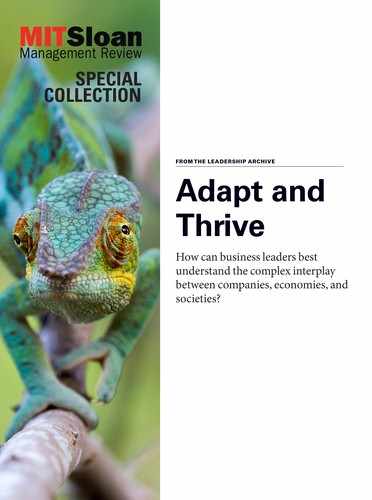How can business leaders best understand the complex interplay between companies, economies, and societies? This collection of articles from MIT Sloan Management Review examines how to harness the vast wave of technological and cultural shifts that leaders must navigate.
From “Three Meaningful Strategies for Managing Rapid Change”:
- Many companies pursue superficial adaptations when confronted with rapid change, such as creating a transformation office unconnected to the rest of the organization or digitizing processes without rethinking the organization’s business mode.
- Instead, an organization’s C-suite should visibly give permission to — and reward — the parts of the organization that deliver results differently and better.
- Leaders should adapt the practiced values and goals of the organization to the changing world, rather than just change mission statements.
- Leaders should encourage everyone throughout the organization to be a positive change agent. They also must learn to manage the friction of stepping outside the status quo.
From “The Five Steps All Leaders Must Take in the Age of Uncertainty”:
- Systemic uncertainty feeds into corporate decision-making: As companies are exposed to global economic and political forces, their performance swings are increasingly due to noncompetitive effects.
- Acknowledging the unpredictability, nonlinearity, and circularity of cause-and-effect relationships within these systems is a notable departure from the simpler, linear models that underpin traditional mechanistic management thinking.
- The new leadership paradigm is that corporate executives need to move beyond only managing their own companies and must become active influencers within broader systems.
- Five specific steps can help leaders shape the extended systems in which they participate.
From “Digital Disruption Is a People Problem”:
- Many treatments of digital disruption incorrectly regard the rapid pace of technological innovation as the key problem facing organizations.
- The true challenge facing organizations with respect to digital disruption is people — specifically, the different rates at which people, organizations, and policies respond to technological advances.
- Companies will effectively navigate the challenges posed by digital disruption if they look at them as organizational and managerial problems, not as technical problems.
- For instance, when they must adapt to new circumstances, companies should pay the most attention to the adaptation gap with respect to customer engagement and experience.
From “Six Principles for Strategic Migrations”:
- In the fast-moving landscape of modern organizations, it can be difficult to keep pace with competitors and adapt strategically.
- One surprising place that companies should look for inspiration is the animal kingdom.
- In the wild, the various types of animal movement consist of station-keeping, ranging, and migration.
- For instance, when migrating, animals often pass by seemingly suitable locations with abundant resources on the way to a more optimal destination that serves a larger purpose for the species. Some companies exhibit similar behaviors when pursuing strategies.
From “What the Military Can Teach Organizations About Agility”:
- U.S. armed services are experimenting with ways to make faster — and smarter — decisions, and business should take note.
- Once bastions of command-and-control management style, modern military institutions such as the U.S. Marine Corps are at the forefront of thinking about organizational agility. That has been essential in an era of digitally enabled terrorism.
- Military thinking now emphasizes the kind of innovation necessary to move leaders efficiently through the four decision cycles of Observe, Orient, Decide, and Act in order to ensure that forces are best able to respond quickly to sudden external threats.
- For instance, military leaders focus only on decisions they can make, letting teams closest to the problems make decisions and take action decisively and independently.
..................Content has been hidden....................
You can't read the all page of ebook, please click here login for view all page.
